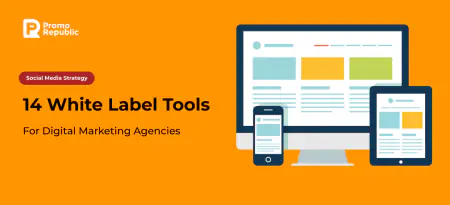How to Create a Professional Marketing Portfolio for Your Agency [2021]

Content writer and blog editor at PromoRepublic
How can marketers demonstrate that they have the necessary experience? Of course, with the aid of a marketing portfolio. Clients no longer want to hear about your abilities; instead, they want to see them in action. This is where a portfolio can help. It gives you the ability to tell your story through your work and achievements.
A marketing portfolio is a great way to promote your best work when you need to showcase what you’ve already done as a marketer or connect with potential clients. Everything you’ve worked on will be well-organized and accessible. There’s no need to prepare extra files or send lengthy emails describing your previous experience.
In the article, we will explain what a marketing portfolio is, why it’s important for your agency, and how to create a successful and professional marketing portfolio.
What is a Marketing Portfolio?
A marketing portfolio is an organized collection of relevant work that shows potential employers your abilities and expertise. It also helps you chart your professional growth.
A marketing portfolio includes a company brief, professional accomplishments, career summary, contact details, marketable skills and abilities, your work samples, testimonials, and awards.
Why Do You Need a Marketing Portfolio?
Clients looking for a marketing agency need to be sure that the agency they want to hire is trustworthy and will provide a return on their investment.
Proof that you’ve done similar work before and got amazing outcomes is a great way to establish trust and credibility with potential clients. A marketing portfolio can also be used to demonstrate the breadth of your talents and experience.
In the digital age, it is preferable to create a marketing portfolio as a website. A marketing portfolio in the form of a website can serve as an inspiration for potential collaborators. Your clients will be able to visualize the types of projects you’ll create for them if you show them interesting examples of your work.
Placing your professional portfolio online can also help you build credibility in your field. It also helps in developing your employer’s brand; people will find your company and contact you about job openings.
What to Include in a Marketing Portfolio
Here’s a checklist of the components you should include in your marketing portfolio:
- A company brief (short bio): highlight your interests, experience, and knowledge. This is also a great place to include a mission statement – an explanation of why you believe your company’s work is important.
- Career summary: include your professional accomplishments to highlight your experience and provide context to your work. You can include information about employees’ work records and academic backgrounds.
- Contact details: make it easier for your potential clients to find your professional email address and phone number in your portfolio. If you have any social media accounts related to your profession, such as Instagram, LinkedIn, or Facebook pages that cover your work, you should also link to them.
- Work samples: this is the most important aspect of your marketing portfolio. Share the most successful and good-looking projects, as well as details of the workflow and your approach to work. Each explanation should be accompanied by compelling visuals and data-driven metrics.
- Testimonials: place positive customer testimonials along with your work examples to make a powerful first impression. Assuring people that your work was well received by clients might help to increase the credibility of your claims.
- Awards: don’t forget to add to your portfolio any public acknowledgment you have received, whether it is an award in your field or a mention in a publication. This will help you establish yourself as an industry expert.
- Call to action: a call to action (CTA) is a piece of advertising that encourages your viewers to take a specific action. Make sure you include one at the end of your portfolio.
Your portfolio’s sole objective is to demonstrate how successfully your agency performs the work you do, therefore only exhibiting your best, most recent work.
It’s important to remember that you don’t have to exhibit all of your work. What you should be aiming for is a selected set of works that you’ve done previously on various projects.
Your portfolio should demonstrate your greatest work, regardless of what type of marketer you are. If you only include old projects it may seem like your agency is no longer operational. It can also give the impression that you are unable to keep up with the ever-changing marketing industry, which is not a good sign if they hire you to do this. Including substandard work in your portfolio can be just as bad as including old works.
How to Create a Digital Marketing Portfolio Clients Love (Examples and Strategy)
We have put together a guide on how to build a marketing portfolio that will showcase your best work and get your audience’s attention:
- Choose an online platform
A convenient way to get started with your online portfolio is to create a professional website. You can choose between these website builders:
- WordPress is a versatile site builder with plans for every budget;
- Wix is a free website builder with a variety of templates that you can customize;
- GoDaddy is a free website builder that allows you to create mobile-friendly sites with modern templates;
- Weebly is a free site builder with an intuitive drag-and-drop interface;
- Create an attractive landing page
Keep in mind that the landing page of your professional portfolio website is often your audience’s initial impression of your brand. Your homepage should scream about what you are doing. Make it obvious from the start what your company is about. Use one or two sentences to introduce your site and company, briefly describing your professional objectives. You should also make the landing page pleasing to the eye and simple to browse. Don’t overfill the page with heavy photos or blocks of text. Remember that your purpose is to direct your visitors to other parts of your site, not to keep them on the page. With this in mind, make your homepage as straightforward as possible.
Furthermore, near the top of the webpage, you should include enticing calls-to-action (CTAs), such as “Contact me” or “Choose your project now” buttons.
- Create a strong About Us page
Remember to include the About Us page. On this page, you can provide a brief description of your company as well as links to your social media profiles. This page should describe your professional experience and accomplishments in a way that sets you apart from other industry professionals. It should explain how you got to your current situation and why your organization is doing what it is doing.
You can also include multiple customer testimonials to back up your claims and demonstrate that you are committed to your professional ideals.
- Show off your best work
Your work samples are the most important part of your portfolio. Create a separate page titled Portfolio or Work Samples to begin. This is where you’ll put your best work on display.
You’ll probably have several options to pick from. Rather than attempt to showcase all of them, carefully select the ones that best represent what you’re capable of. Keep in mind that in this case, quality outweighs quantity. First of all, site visitors don’t want to go through dozens of samples to find your greatest work. Second, a thorough analysis of five projects is significantly more fascinating than a cursory analysis of twenty.
- Describe your workflow
Explain the work process of each project. You can place these explanations next to examples of your work, or share case studies and other insights on your website’s blog.
Include the following aspects in your workflow explanation :
- Each project’s objectives
- The difficulties you encountered and how you overcome them
- An outline of the process from beginning to end
- The final product and outcomes
- Make it easy for people to reach you
Make it easy for visitors to contact you by including your contact information on the website. Consider where people might look for your contact information and include it there. This includes the footer of the website, the About Us page, and a separate Contact page.
A contact form should also be included on your website. Visitors will no longer have to copy and paste your email address into a new tab, but will instead be able to send a message immediately through your website.
Marketing Portfolio Examples
Incast, an influencer marketing agency, helps brands and social media influencers form collaborations. Instead of going to a separate page to find their marketing portfolio, visitors can learn about their work simply by scrolling down their homepage. They provide numerous examples of pet films they developed for social media, using both eye-catching visuals and excellent data to demonstrate their effectiveness.
For the past two years, Dani Hart and Sean Ellis have been helping to create the GrowthHackers community. Dani recently made the decision to concentrate on her own business and build her marketing portfolio.
The simplicity of this marketing portfolio is what makes it so enticing. Dani Hart also emphasizes the importance of explaining her marketing strategy before discussing her accomplishments. Anyone interested in working with her will know exactly what to expect right immediately.
Marijana Kay focuses her writing on SaaS and startups, which you’ll notice immediately on her homepage. She’s also interested in long-form writing and has worked with companies like Pipedrive and Recart.
Conclusion
Now that you’ve put together an agency portfolio, you’ve got a powerful tool that’ll help you attract more clients and unconsciously induce them to contact you.








